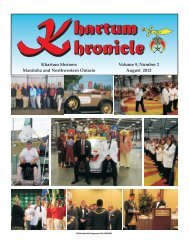K
Color Version - Khartum Shriners
Color Version - Khartum Shriners
- No tags were found...
You also want an ePaper? Increase the reach of your titles
YUMPU automatically turns print PDFs into web optimized ePapers that Google loves.
The Passing Parade<br />
. . . and You Were There . . .<br />
By Illustrious Sir Ken Kristjanson, P. P., October 2013<br />
icture this: the time was the late 1870s and Europe’s middle<br />
class was awash in riches from the New World. This<br />
PVictorian-era leisure class had an affinity for art, communication,<br />
and travel. The relatively new photographic technology<br />
provided a way to show off their wealth and experiences<br />
to friends and family far and near. Whole families would<br />
have their picture taken and lithographed copies made. They<br />
would write all over the front and for a few pennies, bring far<br />
flung relatives up to date on their local happenings. Postcards<br />
were deemed to be letters and traveled with letter postage. The<br />
undivided back of the postcard could only contain the address<br />
— no message was allowed.<br />
Tripoli Temple Shrine Mosque, Milwaukee, Wisonsin Postcard<br />
Reverse Side of Tripoli Temple Shrine Mosque Postcard<br />
At the same time, the French, Dutch, Belgian, German, Russian,<br />
Spanish, Italian, Ottoman, and Austro-Hungarian<br />
empires liked the idea of showcasing their history and progress<br />
in a format that was interesting to look at and easily sent<br />
anywhere. Postcards were the new marketing medium and<br />
everyone wanted their own. The sudden demand had publishers<br />
scrambling to produce better and more interesting cards.<br />
German publishers were at the forefront technologically —<br />
-32-<br />
their chrome litho process produced millions<br />
of cards depicting every aspect of<br />
life at the time. Postcards were the<br />
Instagram, the Facebook of the era for<br />
sharing photos inexpensively with a<br />
broad audience.<br />
The first privately made postcard requiring postage<br />
was created in Austria in 1869 and postcards rapidly<br />
gained worldwide popularity. Postcards of the Eiffel Tower<br />
produced in 1889 and 1890 kicked the postcard craze into<br />
high gear. By 1901, postcard production was said to be doubling<br />
every six months. The official figures from the U.S.<br />
Post Office for their fiscal year ending June 30, 1908, cite<br />
677,777,798 postcards mailed. At that time, the total population<br />
of the United States was only 88,700,000.<br />
The “Golden Age” of postcards was from 1890 to 1911<br />
— a time that roughly mirrors Winnipeg’s own period of<br />
dramatic growth. Twenty years after becoming a province,<br />
Winnipeg had grown from a backwater HBC post into a<br />
large town. With the arrival of the CPR came land speculators,<br />
settlers, entrepreneurs, professionals, and others from<br />
of all walks of life seeking fame, fortune, or simply a place<br />
to put down roots. Winnipeg rapidly became the largest<br />
city between Toronto and the Yukon and the numbers projected<br />
for the City’s growth were staggering.<br />
The City attempted to do its part to keep up with the<br />
growth — it paved streets, expanded running water and electrical<br />
services, added a street railway, and expanded the<br />
wholesale distribution district. The watchful eye of the everpresent<br />
photographers captured all — they produced thousands<br />
of images documenting the transformation of the city.<br />
The photos were quickly lithographed for a ready market<br />
eager to show the world Winnipeg’s new look.<br />
Changes to postcard rules around 1906 allowed for a<br />
divided back where messages could be written. This further<br />
enhanced their popularity, so many high-quality cards<br />
were produced and in such variety that it became popular<br />
to collect and trade them. For many, this was the only connection<br />
they had with Western Canada or the rest of the<br />
world.<br />
In the 1950s I remember a TV program called “You Are<br />
There.” The series featured re-created glimpses of historical<br />
events and it was narrated by renowned broadcaster Walter<br />
Cronkite. He always closed the program with the words<br />
“What sort of day was it?” A day like all days, filled with<br />
those events that alter and illuminate our times . . . all things<br />
are as they were then, and you were there.”<br />
Just like postcards, the show made history accessible<br />
for millions of people. The show is long gone, but fortunately<br />
we still have postcards to connect us to our history in<br />
a personal way. Many of these postcards were saved in family<br />
photo albums and so they survived to be enjoyed by<br />
future generations. Postcards provide beautiful snapshots<br />
of life around the world at an instant in time. Many also feature<br />
personal notes that give us a first-person link to events<br />
of the past, near and far, historic, and mundane — almost<br />
like you were there.












